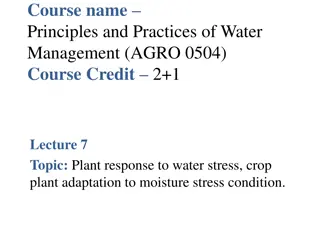Understanding Environmental Stress and Plant Management
Environmental stress, whether biotic or abiotic, can adversely affect plant growth and yield. Factors such as temperature extremes, waterlogging, radiation, chemicals, and pollution can lead to plant strains that may be reversible or permanent. Effective management of stress due to excessive moisture, like waterlogging, is crucial for maintaining plant health and productivity.
Download Presentation

Please find below an Image/Link to download the presentation.
The content on the website is provided AS IS for your information and personal use only. It may not be sold, licensed, or shared on other websites without obtaining consent from the author. Download presentation by click this link. If you encounter any issues during the download, it is possible that the publisher has removed the file from their server.
E N D
Presentation Transcript
Any environmental factor (biotic or abiotic) potentially unfavorable to plant is termed as stress. The effect of stress on plant condition is called strain. Strain may be elastic or plastic strain. Elastic strain: Up to a point, a strain may be completely reversible and relieved, the plant becomes normal. Plastic strain: Beyond the point of elastic strain, the strain may be partially irreversible, which is called permanent set. when the stress is reversible or partially strain plastic or
Environmental Stress Biotic Abiotic Temperature: 1. High 2. Low: a) Chilling b) Freezing Water: 1. Deficit (drought) 2. Excess (submergence & flooding) Radiation: Solar/light Chemical: Salt, ion/gases, agro-chemicals Pollution: Heavy metals Wind, sound, magnetic, electrical
Management of stress due to excessive moisture Effect (1) Waterlogging causes changes in the soil and plant resulting in poor growth and in some cases, death of the plants. The damage depends on crops, stage of crop, period of waterlogging and climatic conditions. Tomato, tobacco, chillies, brinjal, pulsses are most susceptible to waterlogging. Rice is the most resistance crop for waterlogging. Germinating seeds are sensitive to waterlogging due to lack of oxygen.
Effect (2) Seedling stage of the sensitive crops are highly susceptible to waterlogging. Pearlmillet is susceptible to waterlogging during seedling stage while it can tolerate waterlogging at later stages. Yield of cereals is depressed waterlogged during panicle development. Pulses are susceptible reproductive stage. Temperature is the important influencing the effect of damage due to excess moisture. Injury due to waterlogging is severe under warm weather conditions. Flooding is more harmful on sunny days than on cloudy days. Wilting of tobacco takes place only when sunshine occurs after prolonged wet spell. if the soil is at initial period of climatic factor
Why? (1) Waterlogging causes injury to the plant due to low oxygen and accumulation of toxic substances in the soil. The relative importance of these factors for the injury is difficult to explain. Oxygen is depleted completely as the air is exchanged with water. Small pockets of oxygen present in the soil is consumed by micro-organisms within hours after flooding. substances like hydrocarbon sulfide, carbon dioxide etc. develop due to reduced conditions. Leaching of nitrates and de-nitrification increases resulting in nitrogen deficiency. Subsequently gases, toxic hydrogen
Why? (2) Morphological, changes take place in plants due to waterlogging. The important changes senescence, abscission adventitious roots. The proportion of aerenchymatous tissue in the root system increases. Respiration in the roots changes from aerobic to anaerobic respiration with substances accumulate in roots ad damage the root tissue. Ethanol production increases and activity of alcohol dehydrogenase waterlogged plants. Ethanol in large quantities is harmful to plants. anatomical and physiological are and shoot production elongation, of the result that toxic increases in roots of
Why? (3) Permeability of roots decreases due to shortage of oxygen. It results in decreased water uptake and wilting symptoms appear even though soil contains excess water. Permeability of nutrients is also reduced due to some extent by supplying nitrogen fertilizers.
Management To manage water logged lands, it is necessary to classify them with extent of waterlogging: how much and how long. Waterlogging lands may be rainfed or irrigated. The waterlogged classified as: Shallow water (0-30 cm), Intermediate water (30-50 cm), Semi-deep water (50-100 cm) and Deep water (>100 cm standing water). For all ecosystems, management principles are: Crop improvement: breeding and evaluation; Crop management: selection of variety, planting time, population, crop geometry, fertilization Crop protection: management of water, weeds, insect-pests and diseases. lands may be
The swampy lands are low lands and fertile lands from rice cultivation point of view. Over irrigation, continuous accumulation of water and no drainage have transformed these low lands into waterlogged and swamps. The swampy land though exist in negligible percentage may be utilized for cultivation of fish, lily lotus, makhana and after reclamation rice in kharif and berseem in rabi can be cultivated. Iron toxicity occurs also in waterlogged soils. Rice grown in iron toxic soils show bronzing symptoms. Soils with low levels of nutrients such as K, P, Ca, Mg, Si and Mn and Zn or with respiration inhibitors such as H2S may cause iron toxicity even with concentration of Fe as low as 30 ppm (60 kg/ha).
Iron toxicity problems can be ameliorated by: providing deep surface drains diverting soluble Fe++ iron from the field by repeated drainage checking seepage carrying soluble Fe from the upper levels Application of liberal dose of K Application of lime and Growing iron tolerant varieties
Management of flood affected areas Floods refer to great flow of water. It occurs due to heavy rainfall in a short time beyond the capacity of soil to absorb and streams, channels, drains and rivers to carry. Monsoon rainfall pattern brings more than one flood each year and damage crops and properties. If the rainfall is more than the rate of infiltration, it accumulates on the top of the surface and flows down. If there is no way out to flow or drain down, it accumulated and causing water logging.
Floods cause water logging even if drainage is free. To manage such situations from crop production point of view delineation of flood prone areas may be accomplished. With weekly rainfall data over years (usually 30 years or more) flood weeks can be calculated and on this basis, areas likely to be affected by floods can be delineated. Measures/ Contingencies Early planting/sowing, manuring, growing flood resistance varieties, planting vegetative propagation, sowing sprouted seeds on puddle soil, raising seedling stocking more seeds, desilting the leaves and sowing of green gram, blackgram and other pulses after recession of floods to compensate from rice crop loss. aged seedlings, in polyhouses,
Low water stress Moisture stress does not affect all aspects of plant growth and development equally. Some processes are highly susceptible while others are far less affected. The final yield of the crop is the integrated result of these effects of stress on water relations, photosynthesis, respiration, nutrition, growth and development. Moisture regimes during development determines the number of fruits and individual grain weight, respectively. During ripening, which involves dehydration and certain biochemical processes, moisture regime has very little effect on yield components. flowering and grain
For moisture stress at panicle initiation is critical. As the panicle is the organ that is growing most rapidly, it is most affected by stress due to adverse effect on cell expansion. Anthesis is another moisture sensitive stage as moisture stress at this stage causes drying of pollen and loss of viability of pollen. Stress during grain development also reduces yield due to reduction photosynthesis. However, vegetative and grain filling stages are comparatively less sensitive to moisture stress. many crop plants, especially cereals, in leaf area and
The effect of water stress on yield depends largely on what proportion of the total dry matter produced is considered as useful material to be harvested, when the yield consists mostly aerial parts like forage crops, tobacco etc., the effect of moisture stress is the same as those on total growth. When the yield consists of underground storage organs as in potatoes, sugarbeets etc., it will be as sensitive as total growth. When the yield consists of seeds as in cereals, moisture stress at flowering is detrimental. When the yield is fibre where economic product is a small fraction of total dry matter, moderate stress for limited period on growth does not have adverse effect on yields.
Adaptations to moisture stress A. Escaping drought B. Drought resistance 1. Drought avoidance Conserving water (water savers) Improving water uptake (water spenders) 2. Drought tolerance Mitigating stress High tolerance (Ideotype)
Desirable resistance crop are: 1. Rapid germination and early establishment of deep roots 2. Rapid phonological development 3. Developmental plasticity 4. Parahelonastic movements 5. Stomata sensitive only to large vapour pressure deficits and insensitive to low leaf water potential 6. Ability to adjust osmotically 7. Large transfer of assimilates from stem to grain 8. Dehydration tolerance, at seedling and grain filling stages 9. Efficient root system 10. high rate of photosynthesis with thick small leaves plant characteristics for a drought
High temperature and high wind velocity Moderate radiation (400-500 ly/day) and 25-35 C temperature with mild wind velocity (20-30 km/h) are congenial for good growth of crops. High temperature is usually associated with high radiation. It increases respiration working ability. At high atmospheric temperature leaf temperature may remain 5-8 C more. Stomata closes earlier, moisture stress sets in and leaves roll even if there remains ample moisture in the soil. The lag between moisture supply and atmospheric demand increases very fast. and reduces ly= Langley, unit of heat transmission
During summer high temperature usually associates with low soil moisture. Under such situations in rainfed areas, there remains no crop. In irrigated areas, summer rice shows wilting of leaves much before noon and recovers in the afternoon only after the effects of scorching sun is reduced. Leaves become turgid before sun set and drops of water trickle down from tips. In the day time transpiration remains very high and crop ET remains more evaporation. High temperature in general, reduces fertilization, increases sterility and affect fruit set. than twice the pan
High nutrition, shoot growth and pollen development resulting in low yield. High temperature with high humidity and low wind velocity is more harmful than that with high wind velocity. A high velocity wind takes away the harmful effects of high temperature respiration. But high wind velocity has harmful and destructive effects on crops. Like high temperature high wind velocity during flowering increases sterility and decreases fruit set. It is necessary to have windbreaks and shelterbelts to reduce harmful effects of high temperature and high wind velocity. temperature adversely affects mineral and reduces reduces pollination,
Low temperature stress Low temperature affects several aspects of crop growth viz. survival, cell division, photosynthesis, water transport, growth and final yield. Low temperature stress occurs mainly due to frosts in high altitudes and latitudes. Temperate crops like wheat and barley have high resistance to low temperature damage especially at a very early stage. Low temperature stress results in retardation of cell elongation than dell division. However, leaf growth is accelerated after dessation of low temperature. These reactions of the plant are similar to moisture stress conditions.
When C4 plants like maize and sorghum are subjected to low temperature of 10oC, the activity of pyruvate dikinase is reduced, resulting in less photosynthesis. Crops are subjected to low temperature either due to cold waves or frosts. If there is sudden fall in temperature by more than 4oC, plants become chlorotic, roots become pale and less active. This type of behavior is seen in wheat and rice. This yellow syndrome on rice was observed over large areas in winter crop of rice even in the south India. Low temperature causes moisture stress. Entry of water into the plant is restricted due to low permeability of cells. The active transport of water from roots to the shoots is stopped at low temperature.
Temperate crops prefer low temperature during vegetative growth while tropical plants require high temperature. In temperate crops, the optimum temperatures are lower in the early stages and higher at later stages. The optimum temperature reproductive and grain development stages of wheat are 10, 18 and 20oC, respectively. In tropical crops, the optimum temperatures are more in the early stage and less in later stages. The optimum temperature for rice are 31, 30 and 20oC for tillering, flowering respectively. In maize, seedling growth is reduced by 50% at 10oC. for vegetative, and ripening,
Low temperature causes high spikelet sterility in rice. It ranges from 3.6 to 96.8% depending on variety. The critical temperature for spikelet sterility are 15-17oC. A temperature of 12oC for even four days causes considerable spikelet sterility in rice. In a broad sense, booting stage is sensitive to temperature stress similar to moisture stress. As rice is a sink limited crop, whatever may be the cause for stress at sink developing stage, considerable reduction Temperature and moisture development stage is, therefore, more critical. Higher level of N application increases cold susceptibility. However, application of P or FYM increases the tolerance of rice to low temperature induced sterility. in yield occurs. panicle stress at
Nutrients deficiency under high moisture Impeded changes under reduced conditions. These situations cause deficiency or toxicity of certain elements. The disorders consider submerged conditions physiological diseases. But some nutritional disorders may also occur even if the condition is not a submerge directly or indirectly created by weather/climate and many other factors. Crop loss due to such disorders in general can be reduced by management of the ecosystem, drainage, water control, alternate wetting and drying and in few cases by supplementing deficient elements. drainage causes several chemical to be generally caused by are called
Waterlogged soils wherever exists in the state have very poor physical conditions and difficult of be ploughed off in kharif. No bullock or tractor can enter into it. Only manual labour serve the purpose. These lands also suffer from Fe toxicity. The land remains almost fellow in rabi, though some of the farmers cultivate rice or forage in it. Putting these lands idle even in kharif is also common. Drainage and potassium manuring can reclaim these lands. Growing non-tolerant varieties has a little benefit in these lands. It is necessary to identify and delineate submerged area (both in rainfed and irrigated) and evolve strategy of management. waterlogged and
Nutrient availability under moisture stress Most of the nutrients exist in mineral and organic matter and as such are insoluble or unavailable to plants. Nutrients become available through mineral weathering and organic matter decomposition. The nutrient availability process constitutes a sequence of reversible and irreversible reactions. A part from these, other important factors including temperature, light, precipitation, irrigation, leaching and interactions of genotypic characteristics of individual plant species affect nutrient availability. Uptake of nutrients by plants occurs in the form of ions. The major processes which transport ions to the roots are root interception, mass flow and diffusion. and phenotypic
The process of penetration of roots through the soil and thus coming in contact with soil colloids on which nutrients are interception. Some of the nutrients are transported to the roots with water as it is absorbed by plants. This is called mass flow. As the nutrients absorbed concentration gradient occurs between the zone immediately around the root surface and the zone further away. As a result of this concentration gradient, diffusion of ions towards the root surface takes place. held is termed as by plant roots,
In various soils, mass flow mechanism play an important role to supply Ca++, Mg++, NO3-, and SO42-. However in some cases when the mass flow falls and nutrient supply becomes the important process as in the case of P and K. The extent of soil moisture plays an important role in determining the significance of mass flow and diffusion process. Diffusion, however, becomes progressively less important as the moisture content decreases. is insufficient, diffusion
Moisture stress vs. nutrient transformation As the moisture content in soil decreases the concentration of soluble salts in the soil solution increases. This leads to the enhancement of the osmotic potential of subsequently influences plant water relations. The soluble anions are HCO3-, SO42-and Cl-. One of the salts which precipitate first is gypsum (CaSO4.2H2O). Among the cations, if sodium (Na+) is present in soil in significant quantity i.e. in excess of about 6% of CEC, it results in dispersion of soil aggregates and leads to decrease in hydraulic conductivity, increase in soil resistance and crust formation. the soil solution and
Water availability up to certain extent may also affects dissolution (weathering) of soil minerals. This may keep feldspars and other potassium bearing minerals intact and these minerals serve as primary sources of plant available K. Moisture deficiency availability. Drying of soil leads to precipitation of ortho- phosphate (PO4) in various forms of calcium phosphate. In soils falling under precipitated calcium phosphate exists mainly in the form of octa-calcium phosphate, which is a less soluble source of plant available P. affects phosphorus temperate regions
This compound remains in equilibrium not only with soluble PO4, but also with adsorbed P and other calcium phosphate minerals with the equilibrium concentration varying with moisture content of soil, salt concentration, pH and other associated factors. Solubility of nutrients is affected due to moisture stress by way of lowering down of root activity. If root system is highly active, a considerable amount of CO2is liberated into the soil solution which lowers down the pH of the solution and thereby altering the solubility of many minerals.
Insect-pest and disease epidemics Weeds, wild rice and rice serve as perpetuating sources for insect survival and multiplication and infestation from crop to crop in rice areas. Due to introduction of HYVs, responsive to high doses of N and spread of irrigation, many pests which were minor or unknown have become major or and their incidence has increased.
Thank you Thank you























